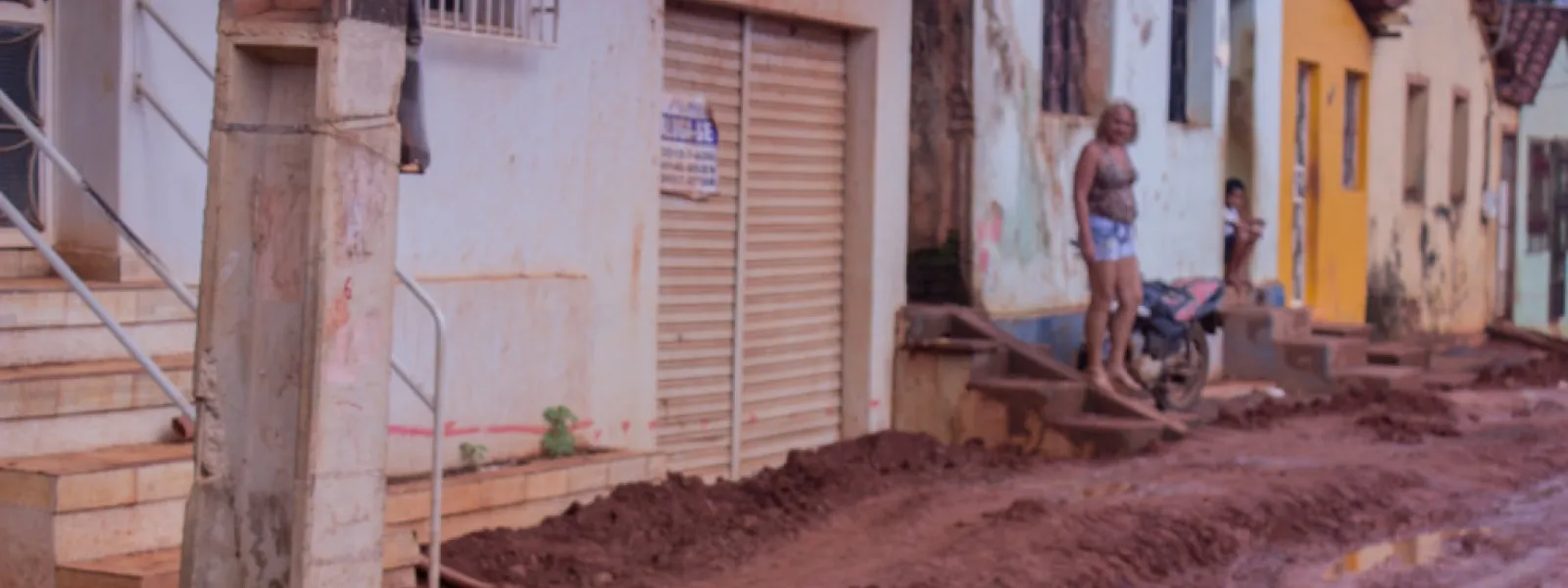
Project
Photo: Maíra Irigaray / Amazon WatchHolding Brazil accountable for the Belo Monte Dam
When fully operational, Belo Monte will be the third-largest dam in the world, constructed in one of the most important ecosystems on the planet: the Amazon rainforest. It sits on the Xingu River in Pará, a state in northern Brazil. The reservoir will cover 500 square kilometers of forest and farmland—an area the size of Chicago.
For the people of the Xingu, construction of Belo Monte has meant loss of access to water, food, housing, work and transportation. At least 20,000 people have been displaced.
The government and construction consortium began to construct the dam without first consulting the people of the region, many of whom are indigenous. They flouted international human rights law, which requires the free, prior and informed consent of affected indigenous communities. Brazil also failed to comply with precautionary measures issued by the Inter-American Human Rights Commission, which were intended to protect the life, health, and integrity of local communities.
Though Belo Monte began operations in May 2016, it is not yet operating at full capacity. In April 2016, a federal court suspended the dam's operating license because the consortium in charge did not complete basic sanitation works in Altamira, the city nearest to and most affected by the dam.
Partners:
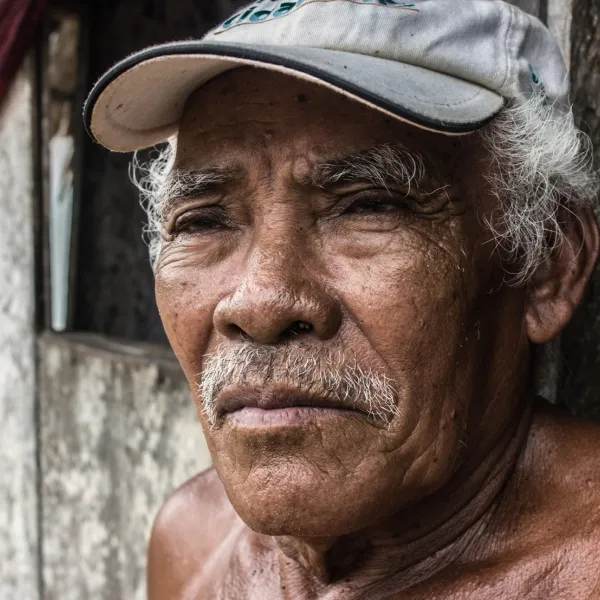
Related projects
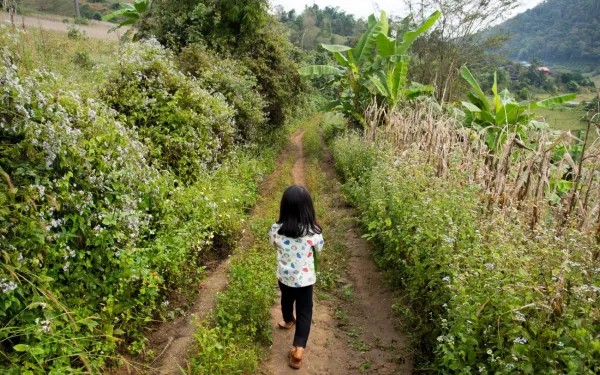
Our vision for a just future
Latin America is key to protecting biodiversity and combating the global climate crisis. Its forests, wetlands and marine ecosystems are among the most important carbon sinks on the planet, a service weakened by activities such as the exploitation and use of fossil fuels. At AIDA, we envision a region where the environment and communities, especially those in highly vulnerable situations, have lasting protections. To achieve this, we select precedent-setting cases that result in new, replicable tools and strategies that add to the protection of a healthy environment in the region. Having celebrated 25 years of working for the right to a healthy environment in the region, AIDA is poised to enter a new quarter century as a robust, multidisciplinary organization. In the coming years, we will continue and strengthen our pursuit of environmental and climate justice through two interconnected initiatives, each with defined lines of work: 1. Promotion of a just energy transition A just energy transition implies transforming the power relations between those who pollute the most and the rest of the world, avoiding the deepening of socio-environmental conflicts and protecting the rights of communities and people involved in energy generation processes. As this is an issue that cannot be addressed only at the national level, AIDA will contribute its regional vision to increase the scope of local and national decisions, enhance legal strategies, and strengthen a proposal for the continent’s transition. We will focus on: Avoiding dependence on oil and gas. Halting the extraction and use of coal. Promoting renewable and sustainable energies. Advocating for human rights-based climate finance and governance. 2. Protection of life-sustaining systems The ecosystem services that sustain life in Latin America and the world—including natural carbon capture and storage to mitigate the climate crisis, and the provision of clean food, air, and water - are at risk due to the lack of ambitious and effective actions. To ensure the livelihoods of life systems on the continent, both in rural communities and large cities, AIDA will focus its efforts on: Protecting the ocean, from the coasts to the high seas. Preserving freshwater sources and traditional territories. Defending culture and traditional livelihoods. Improving air quality. In the coming years, from our regional perspective, we will continue to contribute to solutions that center nature and communities, and that effectively address the continent’s social and environmental challenges.
Read more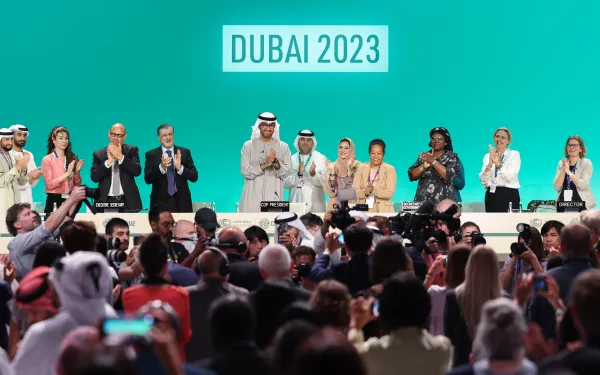
After COP28 in Dubai: The complex road to Baku and Belém
By Javier Dávalos, Claudia Velarde and Marcella Ribeiro* The twenty-eighth United Nations Climate Change Conference (COP28), held in Dubai, United Arab Emirates, was the largest ever in terms of the number of participants. The representatives of the States Parties to the United Nations Framework Convention on Climate Change and the Paris Agreement held intense discussions under the scrutiny of stakeholders from various sectors. The final results lack the clarity and ambition needed to define the next round of Nationally Determined Contributions (NDCs). However, the fact that for the first time in almost 30 years all fossil fuels (coal, oil and gas) were mentioned in the main decision of the meeting represents a before and after in climate negotiations. This fact also marks the way towards the next conferences: COP29 in Baku (Azerbaijan) and COP30 in Belém do Pará (Brazil). Below we take stock of COP28 and analyze its implications for the future of climate action in Latin America and the Caribbean. Progress at COP28 For the first time, the outcome document mentioned the need for a transition away from fossil fuels in energy systems in a fair, orderly and equitable manner, accelerating action in this critical decade. The text of the global stocktake of the state of implementation of the Paris Agreement also clearly stated the goals of tripling renewable energy and doubling energy efficiency. The Glasgow target for reducing methane emissions by 2030 was affirmed, as was the exit from inefficient fossil fuel subsidies. Key elements of the work program on just transition pathways were defined, including its scope, objectives, results and institutional arrangements. What was missing at COP28 With regard to the energy transition, there was a need for greater determination to close the door on false climate solutions. On the one hand, there was a call to accelerate nuclear energy and abatement and elimination technologies (carbon capture, utilization and storage) and, on the other, it was noted that "transition fuels" could facilitate this process while ensuring energy security, implicitly giving a free pass to fossil gas. In terms of adaptation, no real progress was made towards a framework for climate action based on the protection of the ocean, wetlands and forests. Nor was there reinforcement of operational synergies between the key policy processes governing terrestrial, freshwater, coastal and marine ecosystems worldwide. While the first step was taken to operationalize the Loss and Damage Fund, the decision did not include a reference to human rights in its objectives and mission. In addition, it limited the participation of indigenous peoples and local communities on the Board of the Fund under the category of invited observers. It also failed to mention the principle of common but differentiated responsibilities, meaning that the fund would be financed solely by grants. In addition, the World Bank was designated as the fund's administrator, putting at risk that the communities most affected by the impacts of the climate crisis would have access to resources in an agile, direct and debt-free manner. Regarding the just transition, it was not recognized that the energy transition puts different pressures on the territories where raw materials or critical minerals such as lithium, copper and cobalt are obtained. This affects Latin America in particular. As a result, developed and developing nations disagreed on whether to keep the transition at the national or international level. And so the transition was not considered an integral and plural transformation process that implies creating socio-political conditions to restructure the organization, ownership and distribution of the current production and consumption systems for the enjoyment of the right to energy. The countries failed to reach an agreement on the substantive elements of the new quantified financing target. Progress was limited to definitions of the process and procedures for defining it. In 2024, there will be at least three technical dialogues to discuss the elements of the target such as amounts, timelines, financing targets by area, and how progress will be measured. What's next: Heading towards COP29 and COP30 The next climate conferences will have to navigate complex contexts, marked by the long-standing crisis of multilateralism, the unfair distribution of burdens for the energy transition—particularly in terms of the exploitation of critical minerals—,and the growing co-optation of negotiations by the corporate interests of fossil-related companies. In this context, the performance of Latin American countries at COP28 is an indication of how their positions for COP29 and COP30 will be constructed: Brazil sought to position itself as a "climate champion" but could not hide its strong fossil fuel extraction agenda. As host of the upcoming COP30, Brazil tried and failed to explain away membership in the expanded Organization of the Petroleum Exporting Countries (OPEC+) without success. Then, days after COP28, it tendered 613 oil blocks in the Amazon with a view to becoming the world's fourth largest oil producer by 2030. Despite this, Brazil created a new work program on the goal of limiting global warming to 1.5 degrees Celsius, which it will take as a banner to COP30, together with the protection of nature and the fight against deforestation. Colombia, for its part, was the most vocal leader on the urgent need for transition, announcing its accession to the Fossil Fuel Non-Proliferation Treaty and maintaining clear interventions on the exit from fossil fuels in its panels and public interventions, which positions it as a regional leader for the upcoming conferences. Ecuador missed the opportunity to obtain funding and support from the international community to implement the Ecuadorian people's decision to close the ITT oil field in Yasuni Park. This omission could be remedied at COP29 because, beyond the delicate internal context, the South American country has just under a year to comply with the legal obligation to implement this decision and the international community can and should support the decision to close the ITT oil field in Yasuní Park. In another area, and within the process of the Advisory Opinion on the Climate Emergency, AIDA, together with other organizations, requested that the Inter-American Court of Human Rights refer to the decision adopted at COP28 regarding the Loss and Damage Fund, as it does not comply with or satisfy the obligations of States under international human rights law. It is expected that the Court will recognize the right to climate reparations and clarify that the establishment, implementation and operation of this fund does not exclude the possibility of making claims for reparations for losses and damages, nor does it block other judicial or administrative processes, measures or mechanisms for access to justice and comprehensive reparations for people affected by climate impacts. *Javier Dávalos is coordinator of AIDA's Climate Program, Claudia Velarde is co-coordinator of the Ecosystems Program, and Marcella Ribeiro is a senior attorney with the Human Rights and Environment Program.
Read more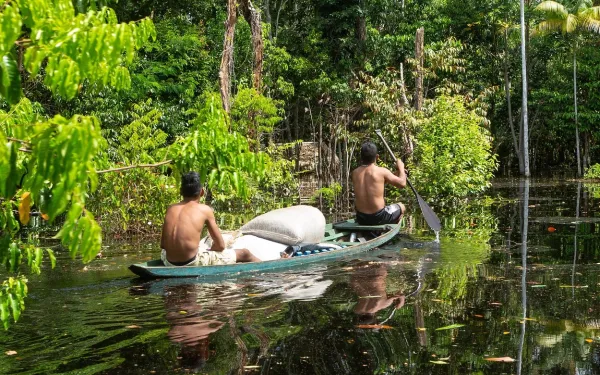
The triple planetary crisis: What is it and what can we do about it?
You may have heard that humanity is facing "a triple planetary crisis.” In the words of United Nations Secretary-General António Guterres, this crisis "threatens the well-being and survival of millions of people around the world." But what exactly does it mean? The triple planetary crisis refers to three interrelated problems: climate change, pollution, and biodiversity loss. Each of these problems is a crisis with its own causes and effects, but all three converge and feed on each other. All three affect human rights, and more intensely impact people in vulnerable conditions. The climate crisis The United Nations considers climate change to be humanity's most urgent problem and the greatest threat to human rights. Climate change, which involves long-term changes to the planet's temperatures and weather patterns, can completely alter ecosystems. Although changes in climate can occur due to the natural patterns of the planet, what we are facing is caused by human activities. Since the Industrial Revolution, there has been an accelerated change in the planet's average temperatures. One of the primary causes of that change is the exploitation and use of fossil fuels. The climate crisis, then, refers to the consequences of climate change caused by human activities, which include: an increase in the intensity and severity of natural events such as droughts, fires, and storms; rising sea levels and the melting of the poles; changes in the hydrological and climatic cycles that affect biodiversity; and impacts on the enjoyment of human rights. The pollution and waste crisis The dominant economic system, dependent on consumption, implies the generation of high levels of pollution and waste that have a great impact on human and ecosystem health. Air pollution is the leading cause of disease and premature death worldwide. The World Health Organization estimates that 7 million people die prematurely each year because of poor air quality. Air degradation is caused by emissions from factories, transportation, and forest fires. Those who lack access to less harmful technologies for cooking or keeping warm also breathe polluted air in their homes. Air pollution is related to climate change, as many of the emissions also warm the planet. Pollution caused by plastics and microplastics is another global concern, as it directly affects biodiversity. An increasing number of studies are finding that plastics are affecting the health of people and other living things. They take centuries to decompose, and are derived from petroleum, a fossil fuel. And we can’t forget pollution caused by extractive activities which, in addition to generating greenhouse gas emissions and leaving in their wake chemicals that are toxic to health, degrade freshwater sources and large tracts of land. The biodiversity loss crisis Biodiversity loss refers to the decrease and disappearance of biological diversity: flora, fauna, and ecosystems. This crisis is caused by the two previous crises, in addition to the overexploitation of resources and changes in land use—which cause overfishing, illegal hunting and trafficking, and deforestation—and the introduction of non-native and invasive species. This loss also implies the decline of many of the species on which we depend. Its impacts extend to affect food supplies and access to fresh water. One example is the Amazon, the world's largest tropical forest and a global climate stabilizer. It is home to 10 percent of the planet's known biodiversity and is the ancestral home of more than 470 indigenous and traditional peoples. The Amazon is endangered by colonization, deforestation, and extractive activities, among other threats. The situation is so serious that the point of no return for the Amazon, in which deforestation levels cancel out its capacity for regeneration, is no longer a future scenario. Actions to confront the triple planetary crisis The triple planetary crisis is a complex problem involving diverse stakeholders and requiring multidisciplinary solutions. Although local actions and individual lifestyle changes can help, many of the necessary actions require decisions on a global scale and profound changes to economic, political, and social systems. According to the United Nations, global actions to confront the crises must include: Limiting global temperature increase to 1.5 degrees: this means that global emissions should be reduced by 45 percent by 2030, with the goal of achieving carbon neutrality by 2050. Accelerating the expansion of clean renewable energies: to achieve the above, a drastic reduction in the use of fossil fuels is required to make way for energy systems based on renewable sources that are sustainable over time and respectful of the environment and people. In addition to combating climate change, this would reduce air pollution. Investing in adaptation and resilience: this means considering those who are already suffering the impacts of the climate crisis in the solutions, with emphasis on the nations, people, and communities in vulnerable situations and who are least responsible for these crises. Conserving and protecting 30 percent of the planet: this applies particularly to areas of biodiversity importance, including the ocean. It also implies actions to mitigate climate change. Improving the food system: this includes changes in irrigation and soil management, as well as producing healthier food and reducing food waste. Leaving no one behind: the measures described above must be carried out simultaneously and with a focus on protecting human rights, as they represent an opportunity to reduce the inequalities that are both a cause and a consequence of the crises. Making progress before the triple crisis These crises threaten not only our basic sources of livelihood, but even our mental health. And while much remains to be done, progress has been made that demonstrates the global cooperation needed to advance on a large scale. We’re happy to share some recent examples of global progress: The High Seas Treaty, designed to protect two-thirds of the ocean, was adopted in June 2023, and will need to be ratified by 60 countries before entering into force. The United Nations recognized the right to a clean, healthy, and sustainable environment as a universal right. 175 nations agreed to develop a global instrument to address plastic pollution. The steps we take as individuals help us to act locally: to live our values and contribute to our communities. But it’s also important we think globally, and demand that our representatives in decision-making bodies guarantee widespread participation and commit to taking key and concerted actions.
Read more